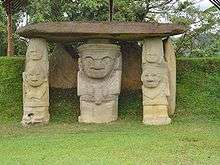El Infiernito
 El Infiernito ("The Little Hell"); ancient astronomical site | |
 Shown within Colombia | |
| Location | Villa de Leyva, Boyacá |
|---|---|
| Region |
Altiplano Cundiboyacense, |
| Coordinates | 5°38′50.63″N 73°33′31.41″W / 5.6473972°N 73.5587250°WCoordinates: 5°38′50.63″N 73°33′31.41″W / 5.6473972°N 73.5587250°W |
| Type | Archaeoastronomical site |
| Part of | Pre-Muisca sites |
| History | |
| Material | Sandstone |
| Periods | pre-Herrera Period-Late Muisca |
| Cultures | Herrera-Muisca |
| Satellite of | Muisca Confederation |
| Site notes | |
| Archaeologists | Eliécer Silva Celis, Carl Henrik Langebaek et al. |
| Public access | Yes |
El Infiernito (Spanish for "The Little Hell"), is a pre-Columbian archaeoastronomical site located on the Altiplano Cundiboyacense in the outskirts of Villa de Leyva, Boyacá, Colombia. It is composed of several earthworks surrounding a setting of menhirs (upright standing stones); several burial mounds are also present.[1] The site was a center of religious ceremonies and spiritual purification rites, and also served as a rudimentary astronomical observatory.[2]
History
The area was known by this name long before the discovery of the archaeological site. Spanish Conquistadors called it infiernito, or "little hell," because they thought it was diabolical and labeled it as a site of Pagan worship. The first description of the site was made in 1847 by the Colombian army geographer Joaquin Acosta, who reported 25 stone columns, half-buried in the Monquirá Valley.[3] The findings were studied by Alexander von Humboldt who believed that the site could be used to anticipate astronomical phenomena such as solstices and equinoxes, as indicated by the alignment of the stones with the sun and moon.[4]
Description
The lithic pieces are carved in pink sandstone, many of them in columnar shapes with an incised ring. A total of 109 monoliths have been excavated to date: 54 in the north stone row and 55 in the south, aligned in an east-west orientation, apparently representing the Muisca calendar,[5] dividing the area in two main parts: the north sacred field (Infiernito N° 1) and the south sacred field (Infiernito N° 2).
Chronology
Archaeological excavations have collected a large number of samples of wood charcoal which have been useful for radiocarbon dating. Three distinct stratigraphic levels can be observed, showing an early inhabitation of the Altiplano Cundiboyacense:
- IAN - 119 - "El Infiernito", N° 2: 2.490 ± 195 years Before Present
- IAN - 128 - "El Infiernito", N° 1: 2.180 ± 140 BP
- IAN - 148 - "El Infiernito", N° 2: 2.880 ± 95 BP
The first stratum is rich in animal remains, vegetal ashes, red ochre, incienso and resins. The second one shows mainly remains of maize oblations. In the third stratum, several pieces of burned carved rocks and lithic flakes, in the remains of a large bonfire, are gathered around a large monolith in the south sacred field.
Threats
The first formal archaeological excavations at the site were led by anthropologist Eliecer Silva Celis in 1981; these resulted in the declaration of the site as an archaeological park. The burial mounds were found to have been heavily affected by grave robbery, and the human remains dispersed. The central column (about 5 meters high) described by Joaquin Acosta in 1850, which apparently allowed the measuring of the sun's astronomical alignment during the equinoxes, was missing.[5] The column alignments have been the subject of a more detailed study by archaeoastronomer Juan Morales who has found that the main columns are aligned at an azimuth of 91° to the top of Morro Negro hill pointing to the rise of the sun in the equinox. The summer solstice sun will be seen from the columns rising above the sacred Lake Iguaque, birthplace of the Muisca.[6]
Other monuments
Other lithic monuments of the Muisca culture exist in Sutamarchán, Tunja, Ramiriquí, Tibaná and Paz de Río among other locations.[5]
See also
 Archaeoastronomy
Archaeoastronomy Muisca astronomy, calendar
Muisca astronomy, calendar Lake Iguaque, Villa de Leyva, Carl Henrik Langebaek, Silva Celis
Lake Iguaque, Villa de Leyva, Carl Henrik Langebaek, Silva Celis
References
- ↑ (Spanish) Investigaciones Arqueológicas en Villa de Leiva. Edición original: 2005-05-13 Edición en la biblioteca virtual: 2005-05-13 Creator: Eliécer Silva Celis - Biblioteca Luis Ángel Arango
- ↑ El Infiernito
- ↑ (Spanish) Colección Colombia Ciencia y Tecnología. Arqueología colombiana Ciencia, pasado y exclusión. Carl Henrik Langebaek Rueda. Instituto Colombiano para el Desarrollo de la Ciencia y la Tecnología Francisco José de Caldas (Colciencias)
- ↑ (Spanish) Arqueología de Colombia. Un texto introductorio. Gerardo Reichel-Dolmatoff. Biblioteca Luis Ángel Arango.
- 1 2 3 "Investigaciones arqueológicas en Villa de Leiva" (in Spanish).
- ↑ Morales, 2005
Further reading
- Langebaek Rueda, Carl Henrik. 2005. Fiestas y caciques muiscas en el Infiernito, Colombia: un análisis de la relación entre festejos y organización política - Festivities and Muisca caciques in El Infiernito, Colombia: an analysis of the relation between celebrations and political organisation. Boletín de Arqueología 9. 281–295.
- Morales, Juan David. 2009. Archaeoastronomy in the Muisca Territory, 272–276. 409; Astronomical Society of the Pacific. Accessed 2016-07-08.
External links
- (Spanish) Parque Arqueológico El Infiernito
- Cooper, Jago, and Carl Henrik Langebaek. 2013. The Lost Kingdoms of South America - Episode 3 - Lands of Gold - El Infiernito. Accessed 2016-07-14.
